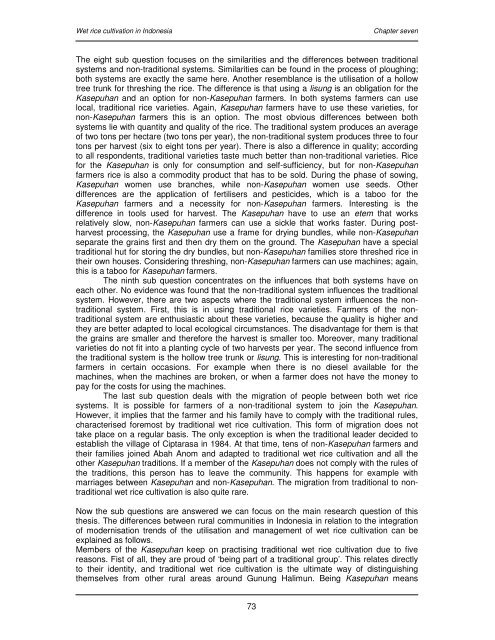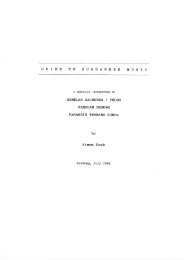Wet rice cultivation in Indonesia - Free EBooks Library
Wet rice cultivation in Indonesia - Free EBooks Library
Wet rice cultivation in Indonesia - Free EBooks Library
Create successful ePaper yourself
Turn your PDF publications into a flip-book with our unique Google optimized e-Paper software.
<strong>Wet</strong> <strong>rice</strong> <strong>cultivation</strong> <strong>in</strong> <strong>Indonesia</strong> Chapter seven<br />
The eight sub question focuses on the similarities and the differences between traditional<br />
systems and non-traditional systems. Similarities can be found <strong>in</strong> the process of plough<strong>in</strong>g;<br />
both systems are exactly the same here. Another resemblance is the utilisation of a hollow<br />
tree trunk for thresh<strong>in</strong>g the <strong>rice</strong>. The difference is that us<strong>in</strong>g a lisung is an obligation for the<br />
Kasepuhan and an option for non-Kasepuhan farmers. In both systems farmers can use<br />
local, traditional <strong>rice</strong> varieties. Aga<strong>in</strong>, Kasepuhan farmers have to use these varieties, for<br />
non-Kasepuhan farmers this is an option. The most obvious differences between both<br />
systems lie with quantity and quality of the <strong>rice</strong>. The traditional system produces an average<br />
of two tons per hectare (two tons per year), the non-traditional system produces three to four<br />
tons per harvest (six to eight tons per year). There is also a difference <strong>in</strong> quality; accord<strong>in</strong>g<br />
to all respondents, traditional varieties taste much better than non-traditional varieties. Rice<br />
for the Kasepuhan is only for consumption and self-sufficiency, but for non-Kasepuhan<br />
farmers <strong>rice</strong> is also a commodity product that has to be sold. Dur<strong>in</strong>g the phase of sow<strong>in</strong>g,<br />
Kasepuhan women use branches, while non-Kasepuhan women use seeds. Other<br />
differences are the application of fertilisers and pesticides, which is a taboo for the<br />
Kasepuhan farmers and a necessity for non-Kasepuhan farmers. Interest<strong>in</strong>g is the<br />
difference <strong>in</strong> tools used for harvest. The Kasepuhan have to use an etem that works<br />
relatively slow, non-Kasepuhan farmers can use a sickle that works faster. Dur<strong>in</strong>g postharvest<br />
process<strong>in</strong>g, the Kasepuhan use a frame for dry<strong>in</strong>g bundles, while non-Kasepuhan<br />
separate the gra<strong>in</strong>s first and then dry them on the ground. The Kasepuhan have a special<br />
traditional hut for stor<strong>in</strong>g the dry bundles, but non-Kasepuhan families store threshed <strong>rice</strong> <strong>in</strong><br />
their own houses. Consider<strong>in</strong>g thresh<strong>in</strong>g, non-Kasepuhan farmers can use mach<strong>in</strong>es; aga<strong>in</strong>,<br />
this is a taboo for Kasepuhan farmers.<br />
The n<strong>in</strong>th sub question concentrates on the <strong>in</strong>fluences that both systems have on<br />
each other. No evidence was found that the non-traditional system <strong>in</strong>fluences the traditional<br />
system. However, there are two aspects where the traditional system <strong>in</strong>fluences the nontraditional<br />
system. First, this is <strong>in</strong> us<strong>in</strong>g traditional <strong>rice</strong> varieties. Farmers of the nontraditional<br />
system are enthusiastic about these varieties, because the quality is higher and<br />
they are better adapted to local ecological circumstances. The disadvantage for them is that<br />
the gra<strong>in</strong>s are smaller and therefore the harvest is smaller too. Moreover, many traditional<br />
varieties do not fit <strong>in</strong>to a plant<strong>in</strong>g cycle of two harvests per year. The second <strong>in</strong>fluence from<br />
the traditional system is the hollow tree trunk or lisung. This is <strong>in</strong>terest<strong>in</strong>g for non-traditional<br />
farmers <strong>in</strong> certa<strong>in</strong> occasions. For example when there is no diesel available for the<br />
mach<strong>in</strong>es, when the mach<strong>in</strong>es are broken, or when a farmer does not have the money to<br />
pay for the costs for us<strong>in</strong>g the mach<strong>in</strong>es.<br />
The last sub question deals with the migration of people between both wet <strong>rice</strong><br />
systems. It is possible for farmers of a non-traditional system to jo<strong>in</strong> the Kasepuhan.<br />
However, it implies that the farmer and his family have to comply with the traditional rules,<br />
characterised foremost by traditional wet <strong>rice</strong> <strong>cultivation</strong>. This form of migration does not<br />
take place on a regular basis. The only exception is when the traditional leader decided to<br />
establish the village of Ciptarasa <strong>in</strong> 1984. At that time, tens of non-Kasepuhan farmers and<br />
their families jo<strong>in</strong>ed Abah Anom and adapted to traditional wet <strong>rice</strong> <strong>cultivation</strong> and all the<br />
other Kasepuhan traditions. If a member of the Kasepuhan does not comply with the rules of<br />
the traditions, this person has to leave the community. This happens for example with<br />
marriages between Kasepuhan and non-Kasepuhan. The migration from traditional to nontraditional<br />
wet <strong>rice</strong> <strong>cultivation</strong> is also quite rare.<br />
Now the sub questions are answered we can focus on the ma<strong>in</strong> research question of this<br />
thesis. The differences between rural communities <strong>in</strong> <strong>Indonesia</strong> <strong>in</strong> relation to the <strong>in</strong>tegration<br />
of modernisation trends of the utilisation and management of wet <strong>rice</strong> <strong>cultivation</strong> can be<br />
expla<strong>in</strong>ed as follows.<br />
Members of the Kasepuhan keep on practis<strong>in</strong>g traditional wet <strong>rice</strong> <strong>cultivation</strong> due to five<br />
reasons. Fist of all, they are proud of ‘be<strong>in</strong>g part of a traditional group’. This relates directly<br />
to their identity, and traditional wet <strong>rice</strong> <strong>cultivation</strong> is the ultimate way of dist<strong>in</strong>guish<strong>in</strong>g<br />
themselves from other rural areas around Gunung Halimun. Be<strong>in</strong>g Kasepuhan means<br />
73








